A progression of relentless efforts to commemorate New Jersey’s abundant transportation heritage have found renewed focus at Boonton’s Grace Lord Park, where the mighty splendor of the Rockaway River gorge traces a forgotten industrial past.
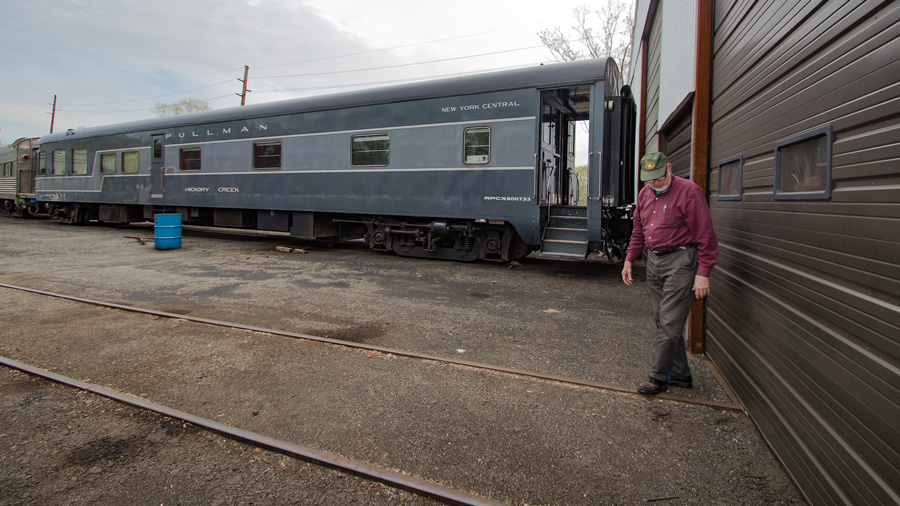
Bill McKelvey paces United Railroad Historical Society of NJ's (URHS) rail yard along Morris Avenue in Boonton, pointing here and there, issuing non-stop commentary. The URHS is a conglomeration of thirteen historical railroad societies, all with the common goal of preserving the largest collection of New Jersey-centric historic locomotives and railroad cars. Approximately forty historic railroad artifacts are undergoing restoration here, and William “Captain Bill” McKelvey knows each one inside and out, with his own Liberty Historic Railway organization (LHRy) funding a fair portion of the work. There are rail cars and locomotives of all shapes and sizes, along with a collection of their constituent components strewn about. An old forty-foot Jersey Central boxcar, rusted through “like Swiss Cheese” is destined for scrap after usable handrails and other miscellaneous items are removed. A bedroom lounge car acquired from Ringling Bros. Circus, which used it as a dormitory, has been beautifully restored by the URHS resident contractor, Star Trak, and awaits charter service.
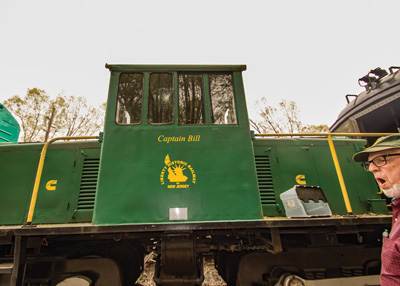
Around back, McKelvey’s Army truck awaits fourteen-foot-long fiberglass bench seats that he found “from a guy in Pennsylvania for only $50. I think that’s a bargain!” There’s a rare ALCo locomotive, purchased by LHRy for $45,000 and donated to the Morristown-based Tri-State Railway Society. A trail of cabooses stretches behind. Hidden under a tarp, a Newark city subway trolley car anticipates a benefactor. At great expense, the “Thomas Alva” locomotive was resurrected from “pile of junk” status until they found that the engine needed to be removed for repair. They had to walk away. But another engine, glowing forest green and emblazoned with the LHRy logo, with his name on it, does in fact belong to Captain Bill, “the only regularly operating locomotive in this yard to move stuff around.”
As we walk further through this field of gigantic machinery, McKelvey’s mood darkens. “The yard stretches way out and you can’t protect everything,” he says. Vicious vandals have attacked a rare Lackawanna Railroad parlor/commuter car that had been painstakingly refurbished. “It’s very depressing to us to see all this damage done on a car that has been through a three-and-a-half-year restoration project. It’s senseless. Apparently they climbed up a ladder and punched holes in each window down the line. Fortunately they didn’t throw a lot of rocks.” Why would someone do such a thing?
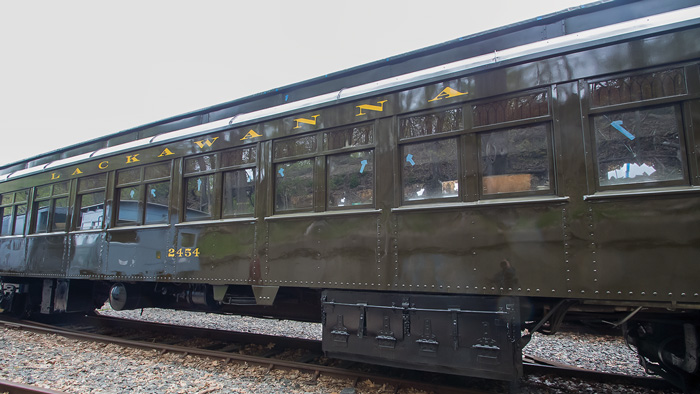
Gleaming with a new paint job the color of milk chocolate, the iconic “LACKAWANNA” in broad gold letters across the top, commuter car No. 2454 had just completed a restoration costing hundreds of thousands of grant and donated dollars. Among the finishing touches, the individual wicker seats that held the well-heeled riders of this luxury “subscription” parlor car, had been duplicated in India, and were soon to arrive. The damage was eventually repaired, and No. 2454 found service for excursions with the Whippany Railroad Museum, a URHS member organization. The Liberty Historic Railway organization helped fund this one also, and Bill personally put up a portion of the $5,000 reward offered to catch the parlor car vandals.
McKelvey, who is now eighty-nine, says he posted his own obituary on his website so they don’t “mess things up.” There is a long list of memberships and achievements for this transportation historian and preservationist, author, publisher, bookseller, lecturer, canal study tour leader, and philanthropist. In 1989, McKelvey was a founding member of the Friends of the New Jersey Transportation Heritage Center, advocating for a way to tell the story of New Jersey’s rich transportation heritage. New Jersey’s credentials as the “birthplace of surface transportation technology and invention” are impressive. John Steven’s pioneering steam locomotive, Edison’s first electric locomotive, early electric street car technology, advances in steam navigation, the mountain climbing Morris Canal, and the first practical railroad in America are lead items in a very long list of state superlatives in the history of American transportation. You can see outstanding collections of New Jersey transportation exhibits... in Pennsylvania, New York, Connecticut, Maryland or Delaware. While there are some fine local rail attractions and sites, there is no comprehensive repository for the images and artifacts of New Jersey’s proud and irreplaceable canal, railroad and roadway heritage, which will soon oxidize into oblivion or be lost to out-of-state museums. In 1999, after several permutations, the state Railroad and Transportation Museum Study Commission finally authorized the development of a master plan for a Heritage Center at Phillipsburg. As McKelvey and scores of other dedicated volunteers anxiously awaited the official designation, Jersey politics tore the plan asunder.
In 2010, having learned never to rely on the whims of public endorsement or state funding, McKelvey formed the non-profit Liberty Historic Railway to educate the public about New Jersey’s transportation heritage by promoting and providing direct monetary grants and other financial support to historic preservation projects and initiatives within the State of New Jersey. An astounding list of noteworthy completed projects includes a few that have been undertaken directly by LHRy. Most notably, the organization undertook a major initiative at Liberty State Park to promote restoration of the seriously deteriorated Central RR of NJ Jersey City (Communipaw) waterfront passenger terminal train shed to be used as a terminus of a proposed trolley shuttle and for the display of rail equipment that formerly used the terminal. After spending nearly $100,000 to advance these objectives, and acquiring a $300,000 grant from the North Jersey Transportation Planning Authority to fund a study that showed the viability of the shuttle proposal, opposition from the Friends of Liberty State Park, and finally the destructive invasion of Super Storm Sandy eradicated all hope for the Jersey City plans.
But Captain McKelvey is nowhere near done. The stage for his latest vision begins in Boonton’s Grace Lord Park, just across Morris Avenue from the URHS yard. The park inhabits a hollow created by the cascading Rockaway River, overlooked by Boonton’s historic district, which sits high on the hillside above the river’s east bank.
Boonton was no exception to the rule of industrial expansion in the iron-ore-rich New Jersey Highlands, following the paths of river, canal and railroad. The first forge appeared along the Rockaway in the mid 1700s, soon joined by a settlement named Boone Town for Thomas Boone, the Colonial Governor. The Boonton Iron Works began operation around 1770, providing products throughout the Revolutionary War and into the early nineteenth century.
Attention was directed a mile up-river in 1830, when the Morris Canal dug its way towards the spot where the Rockaway drops a quick twenty-five feet as it squeezes into a ravine to continue a hundred-foot descent in the next half-mile. The canal’s conjunction with the rushing water made the sliver of real estate along the Rockaway River gorge ideal for the industrial production of iron goods and their commercial distribution. All enterprise shifted to the new mills built there, and the thriving community of Boonton Falls, currently abbreviated as “Boonton”, replaced Boone Town, which has since vanished beneath the Jersey City Reservoir. Canal boats, bringing anthracite coal to fuel the furnaces and taking finished goods to market, spanned an eighty-foot foot elevation through Boonton along one of the canal’s twenty-three inclined planes, its path still plainly visible as Plane Street, between the ironworks basin and the canal prism that continued towards the falls and beyond.
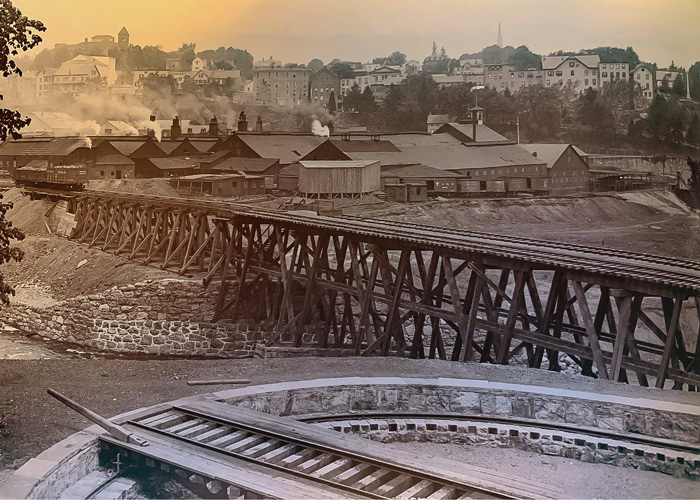
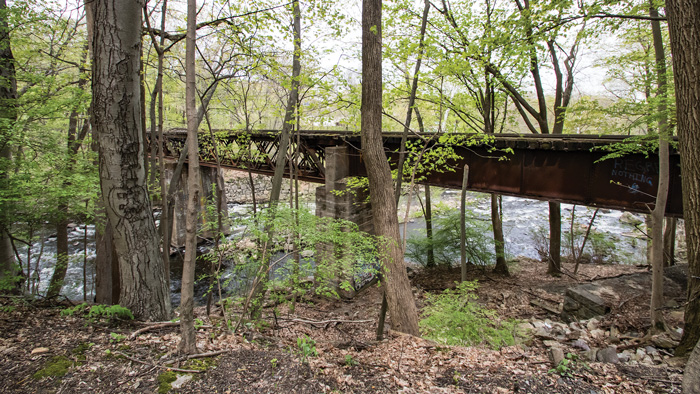
In 1867, a branch of the Morris & Essex Railroad (M&E) arrived from its main line at Denville, spanning the Rockaway River by wooden trestle and dead-ending at Boonton’s hollow, necessitating a fifty-four-foot turntable and engine house above the west riverbank to service the ironworks. Two years later, the Delaware, Lackawanna and Western Railroad (DL&W) took over operations for the M&E, extending the Boonton Branch to Paterson, eventually to join at Hoboken. The upgraded freight routing quickly outpaced the Morris Canal, and as the DL&W also promoted its expanding passenger service, Boonton’s population grew, and the town became an intercity stop between New York and Scranton. New industries replaced the declining ironworks as Boonton continued to attract a variety of manufacturing, including silk, plastics molding, radio and electronics, edible oils and others.
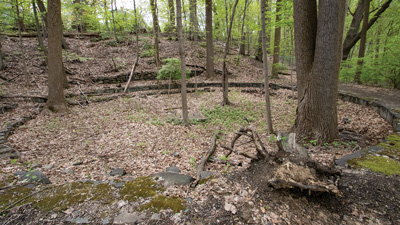
Even after the railroad’s subsequent evolution to Conrail, and then New Jersey Transit, much of the original DL&W infrastructure still stands in Boonton, although only vestiges of foundations and structures from the town’s “iron age” remain. The original M&E wood trestle built over the Rockaway was replaced after a flood in 1896 with a steel truss that still spans the water, with deck girder sections on both ends. Now shrouded in late generation forest, without historic photographs it’s hard to imagine the view as it would have been from the locomotive turntable over the bridge to the ironworks complex and Boonton thriving commercial district rising above. With the exception of a few small trees growing in the middle, the turntable pit is unobstructed. Bill mentions that a set of mechanics for the manual operation of a turntable of this exact size resides at the Pine Creek Railroad Museum of Transportation in Allaire State Park. “They’re not doing anything with it,” he says. “So who knows? Maybe someday we can bring it up here and put back the turntable!”
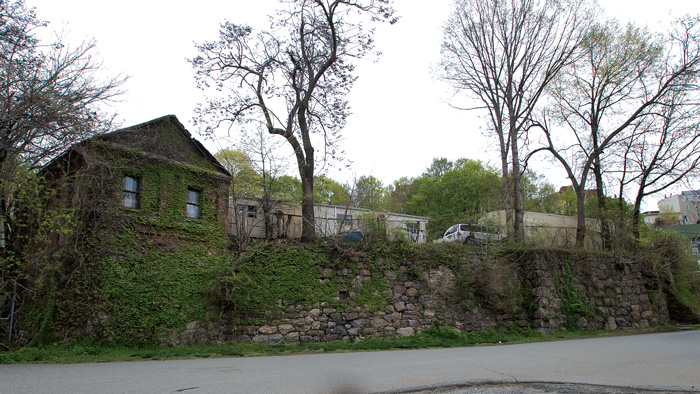
For now, the only approved way across the river is east on Morris Ave to Main Street. At the base of Plane Street we duck into the park and venture on between an ancient stonewall and iron era buildings on one side, and the Boonton’s Department of Public Works yard on the other. At the end of the lane we stand on the river’s former floodplain, now saturated with slag and refuse from the ironworks, facing its opposite shoreline which has collapsed from flooding during Super Storm Sandy. The park trail along the crest that once separated the homes above from the riverbank has vanished.
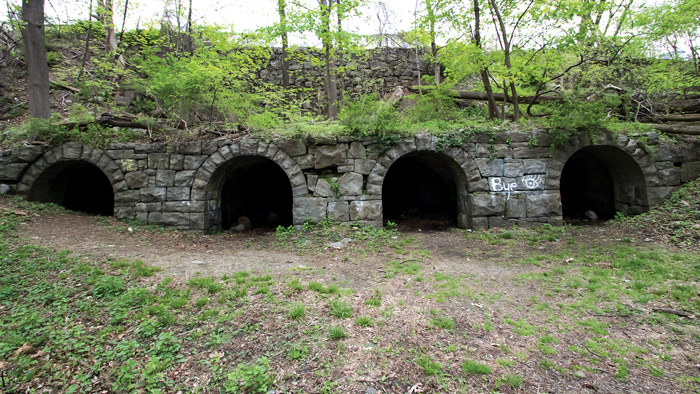
Remains of the Boonton Iron Works lie hidden in the underbrush, barely implying the scope of the rambling industrial complex that once stood there. But trained eyes will recognize the ruins of the furnaces and the system of sidings and platforms that allowed large quantities of raw materials to be loaded first by canal, then by rail. Not far beyond the warehouse there is an intriguing set of tunnel openings, framed with expert stonework from another era, that lead back into the hillside under the old canal basin. Were they part of the anthracite furnace? Part of the canal? Water ducts? Their precise function has yet to be determined, and even for the most knowledgeable authorities of New Jersey’s industrial past, they remain a mystery. “I think this area should be illuminated with soft lights at night,” says Bill, who has a bit of Disney in him, imagining the enticement that these relics might offer visitors. The space also lends itself ideally to interpretive signage to describe all the layers of yesteryear along this historic byway.
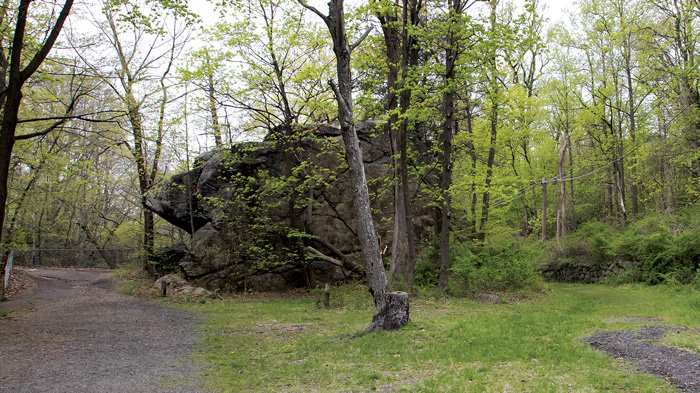
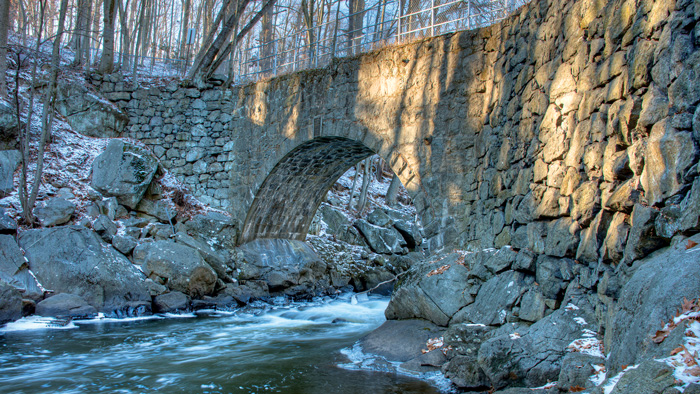
Soon after, the path forks at an impressive boulder called Indian Rock. As imposing as it is today, Indian Rock was once much larger, extending from the riverbank to the Morris Canal prism. It was whittled away, partially for use in the construction of a stone arch bridge in 1857 in order to ferry water from the river dam above through a four-foot iron pipe for fire hydrants at the ironworks. Also known as “Washington Rock”, the boulder has been central to Grace Lord Park’s attraction for tourists since the 1870s. Application has been made for the bridge’s entry on the National Historic Register, so to qualify for restoration funding from Morris County. The repaired bridge will offer hiking access along the extended Morris Canal Greenway.
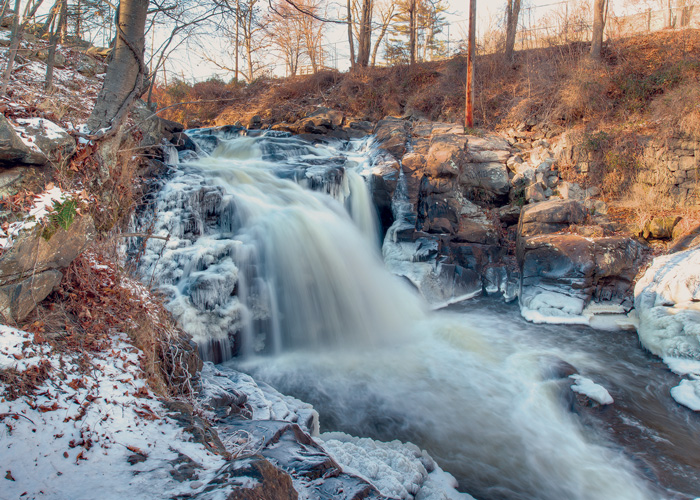
Whatever form McKelvey’s vision for a New Jersey Transportation Heritage Museum takes in its final expression, it will be a welcome complement to other efforts to preserve and promote Boonton’s prolific past. Representatives from Boonton’s Historic Preservation Commission, the Boonton Historical Society, the New Jersey Highlands Coalition, and the Canal Society of New Jersey are all actively engaged in plans to create a Boonton Heritage Trail master plan that will complete the Morris Canal Greenway trail through Grace Lord Park. Keep an eye on those efforts and, meanwhile, take a walk through the park and see what there is to see.
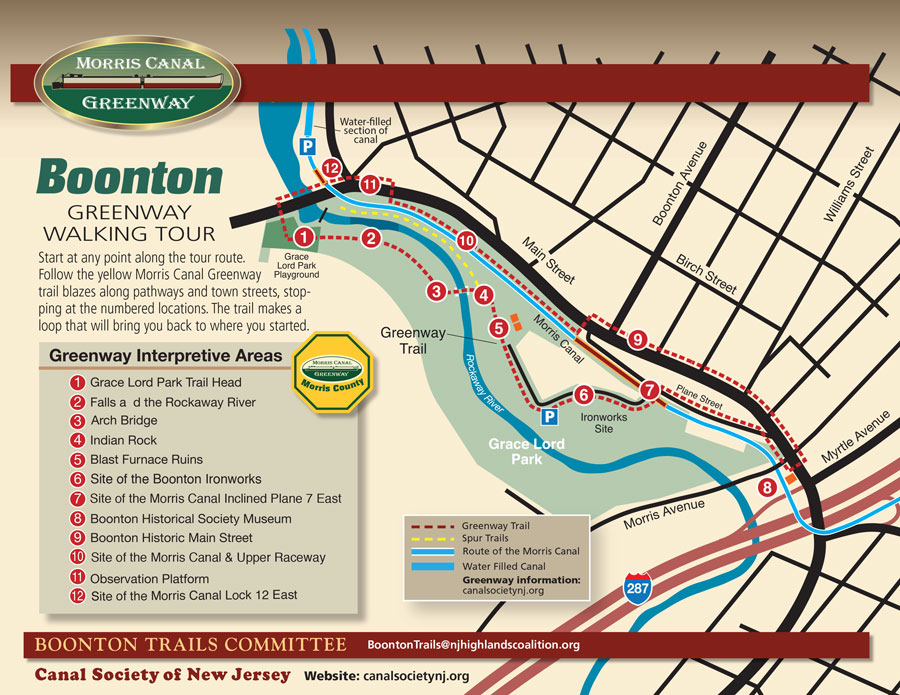
The Boonton Greenway Walking Tour combines the energies of several organizations, including The Canal Society of New Jersey, the New Jersey Highlands Coalition, and the Boonton Trails Committee. “It is ironic that we celebrate the former industries that not only shaped us, but we are also daunted by the ruined and contaminated landscapes they left behind,” observes Elliott Ruga, the Highlands Coalition’s Policy Director. “I don’t think it is inconsistent to study, celebrate and preserve our rich history of industrial and human development. But that endeavor would be wasted if it didn’t inform us how to make better land use decisions today.”
Part of the Morristown National Historic Park, the formal walled garden, 200-foot wisteria-covered pergola, mountain laurel allee and North American perennials garden was designed by local landscape architect Clarence Fowler.
The Millstone Scenic Byway includes eight historic districts along the D&R Canal, an oasis of preserved land, outdoor recreation areas in southern Somerset County
Dedicated to preserving the heritage and history of the railroads of New Jersey through the restoration, preservation, interpretation and operation of historic railroad equipment and artifacts, the museum is open Sundays, April thru October.
Even today, if you needed a natural hideout—a really good one—Jonathan’s Woods could work.
Paths of green, fields of gold!